
The alkaline intrusion Ilimaussaq is located in South Greenland and is one of the prime examples of the rare agpaitic rocks: fractionation under extreme conditions has resulted in strange compositions. The rocks have high contents of alkalis, but so little Al and Si that there is not enough for the usual rock-forming minerals. Rare elements such as REE and Nb can be highly enriched. Rocks in which the normal accessory elements such as zircon and titanite are replaced by complex alkali Zr-Ti-REE silicates such as eudialite are called agpaitic.
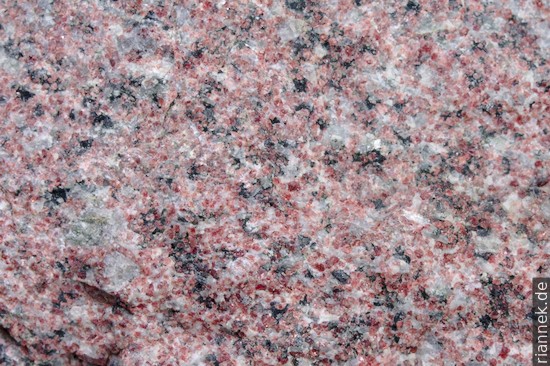
The rocks usually consist of alkali feldspar and nepheline (white), often also sodalite (green and highly fluorescent in Ilimaussaq), eudialite (red to pink) and alkali amphibole (arvfedsonite) and/or alkali pyroxene (aegirine).
The kakortokite is a spectacular example of magmatic layering: a sequence of white, red and black layers (together on average 8 m), in which the minerals alkali feldspar and nepheline, eudialite and arvfedsonite occur in different proportions, is repeated 26 times.
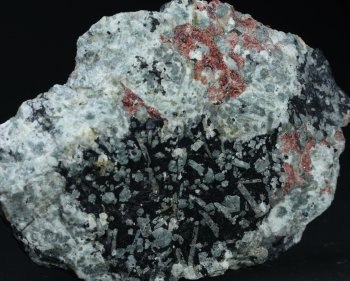
The spectacular naujaite consists of several centimetres large arfvedsonite crystals, alongside alkali feldspar and eudialite, the whole speckled with a large quantity of green sodalite about half a centimetre in size, which has been poikilitically overgrown by the larger crystals.
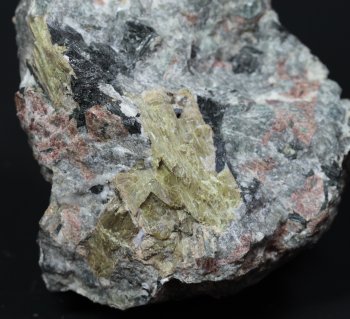
Rinkite (yellow) is somewhat rarer than eudialite, another mineral of the complex alkali Zr-Ti-REE silicates.
Eudialite: Na15Ca6 (Fe2+, Mn2+)3 Zr3 [Si25O73] (O, OH, H2O)3 (OH,Cl)2
Rinkite: Na (Na,Ca)2 (Ca,Ce)4 Ti [F2 | (O,F)2 | (Si2O7)2]
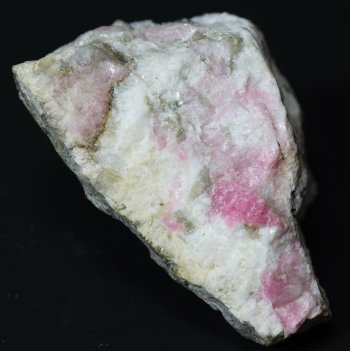
Later hydrothermal formations include rare minerals some of which are found only in Ilimaussaq: among them Na-Be-Sn silicates (!) such as sørensonite and the pink tugtupite, the latter popular among collectors of fluorescent minerals.
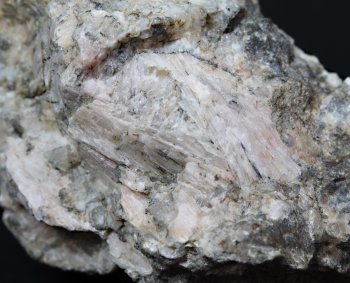
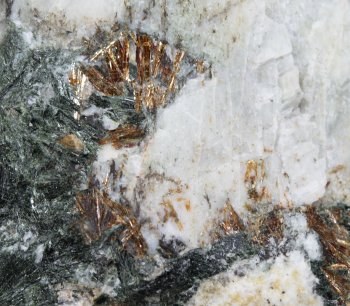
Sørensonite Na4 Sn Be2 Si6O16 (OH)4
Tugtupite Na4 [Cl | BeAlSi4O12]
Literature
Markl, G, Marks, M, Schwinn, G, Sommer, H (2001). Phase equilibrium constraints on intensive crystallization parameters of the Ilimaussaq compex, South Greenland. Journal of Petrology 42, 2231-2258.
Marks, M, Vennemann, T, Siebel, W, Markl, G (2004). Nd-, O-, and H-isotopic evidence for complex, closed-system fluid evolution of the peralkaline Ilimaussaq intrusion, South Greenland. Geochimica et Cosmochimica Acta 68, 3379-3395.
Marks, M, Markl, G. (2003) Ilímaussaq ‘en miniature’: closed-system fractionation in an agpaitic dyke rock from the Gardar Province, South Greenland. Mineralogical Magazine 67, 893-919.
Sørensen, H (1997). The agpaitic rocks; an overview. Mineralogical Magazine 61, 485-498.